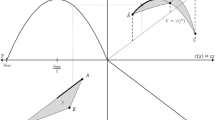Abstract
We develop an efficiency measurement framework for systems composed of two subsystems arranged in series that simultaneously computes the efficiency of the aggregate system and each subsystem. Our approach expands the technology sets of each subsystem by allowing each to acquire resources from the other in exchange for delivery of the appropriate (intermediate or final) product, and to form composites from both subsystems. Managers of each subsystem will not agree to ‘`vertical integration’' initiatives unless each subsystem will be more efficient than what each can achieve by separately applying conventional efficiency analysis. A Pareto Efficient frontier characterizes the acceptable set of efficiencies of each subsystem from which the managers will negotiate to select the final outcome. Three proposals for the choice for the Pareto efficient point are discussed: the one that achieves the largest equiproportionate reduction in the classical efficiencies; the one that achieves the largest equal reduction in efficiency; and the one that maximizes the radial contraction in the aggregate consumption of resources originally employed before integration. We show how each choice for the Pareto efficient point determines a derived measure of aggregate efficiency. An extensive numerical example is used to illustrate exactly how the 2 subsystems can significantly improve their operational efficiencies via integration beyond what would be predicted by conventional analysis.
Similar content being viewed by others
References
Banker, R.D., A. Charnes, and W.W. Cooper. (1984). “Some Models for Estimating Technical and Scale Inefficiencies in Data Envelopment Analysis.” Management Science, 30, 1078–1092.
Charnes, A., W.W. Cooper, B. Golany, R. Halek, G. Klopp, E. Schmitz, and D. Thomas. (1986). “Two Phase Data Envelopment Analysis Approaches to Policy Evaluation and Management of Army Recruiting Activities: Tradeoffs Between Joint Services and Army Advertising.” Research Report CCS no. 532, Center for Cybernetic Studies, The University of Texas at Austin.
Charnes, A., W.W. Cooper, A.R. Lewin, and L.M. Seiford. (1994). Data Envelopment Analysis: Theory, Methodology and Applications. Kluwer Academic Publishers.
Charnes, A., W.W. Cooper, and E. Rhodes. (1978). “Measuring the Efficiency of Decision Making Units.” European Journal of Operational Research, 2, 429–444.
Charnes, A., W.W. Cooper, and R. Thrall. (1986). “Identifying and Classifying Scale and Technical Efficiencies in Data Envelopment Analysis.” Operations Research Letters, 5, 105–116.
Chen, Y. and J. Zhu. (2004). “Measuring Information Technology's Indirect Impact on Firm Performance.” Information Technology & Management Journal, 5, 9–22.
Cook, W., D. Chai, J. Doyle, and R. Green. (1998). “Hierarchies and Groups in DEA.” Journal of Productivity Analysis, 10, 177–198.
Färe, R., S. Grosskopf, and C.A.K Lovell. (1994). Production Frontiers. Cambridge University Press.
Färe, R. and S. Grosskopf. (1996). Intertemporal Production Frontiers: With Dynamic DEA. Kluwer Academic Publishers.
Färe, R. and S. Grosskopf. (2000). “Network DEA.” Socio-Economic Planning Sciences, 34, 35–49.
Färe, R., S. Grosskopf, and S.K. Li. (1992). “Linear Programming Models for Firm and Industry Performance.” The Scandinavian Journal of Economics, 94, 599–608.
Färe, R. and D. Primont. (1984). “Efficiency Measures for Multiplant Firms.” Operations Research Letters, 3, 257–260.
Färe, R. and G. Whittaker. (1995). “An Intermediate Input Model of Dairy Production Using Complex Survey Data.” Journal of Agricultural Economics, 46, 201–213.
Graves, S.C., A.H.G. Rinnoy Kan and P.H. Zipkin. (1993). Logistics of Production and Inventory. North-Holland, Amsterdam.
Hackman, S.T., E.H Frazelle, P.M. Griffin, S.O. Griffin, and D.A. Vlatsa. (2001). “Benchmarking Warehousing and Distribution Operations: An Input-Output Approach.” Journal of Productivity Analysis, 16, 79–100.
Hackman, S.T. and R.C. Leachman. (1989). “A General Framework for Modeling Production.” Management Science, 35, 478–495.
Hackman, S.T. and U. Passy. (2002). “Maximizing a Linear Fractional Function on a Pareto Efficient Frontier.” Journal of Optimization Theory and Applications, 113, 83–103.
Hoopes, B., K.P. Triantis, and N. Partangel. (2000). “The Relationship Between Process and Manufaturing Plant Performance: A Goal Programming Approach.” International Journal on Operations and Quantitative Management, 6, 287–310.
Jehle, G.A. and P.J. Reny. (2001). Advanced Microeconomic Theory, 2nd edn. Addison-Wesley, NY.
Johnson, L.A. and D.C. Montgomery. (1974). Operations Research in Production Planning, Scheduling and Inventory Control. John Wiley, NY.
Löthgren, M. and M. Tambour. (1999). “Productivity and Customer Satisfaction in Swedish Pharmacies: A DEA Network Model.” European Journal of Operational Research, 115, 449–458.
Russell, R. (1985). “Measures for Technical Efficiency.” Journal of Economic Theory, 35, 109–126.
Shephard, R.W. (1970). Theory of Cost and Production Functions. Princeton University Press.
Tayur, S., R. Ganeshan, and M. Magazine. (1999). Quantitative Models for Supply Chain Management. Kluwer.
Troutt, M.D., P. Ambrose, and C.K. Chan. (2001). “Optimal Throughput for Multistage Input–Output Processes.” International Journal of Operations and Production Management, 21, 148–158.
Zhu, J. (2002). Quantitative Models for Performance Evaluation and Benchmarking: Data Envelopment Analysis with Spreadsheets. Kluwer Academic Publishers, Boston.
Author information
Authors and Affiliations
Corresponding author
Rights and permissions
About this article
Cite this article
Golany, B., Hackman, S.T. & Passy, U. An efficiency measurement framework for multi-stage production systems. Ann Oper Res 145, 51–68 (2006). https://doi.org/10.1007/s10479-006-0025-8
Published:
Issue Date:
DOI: https://doi.org/10.1007/s10479-006-0025-8




